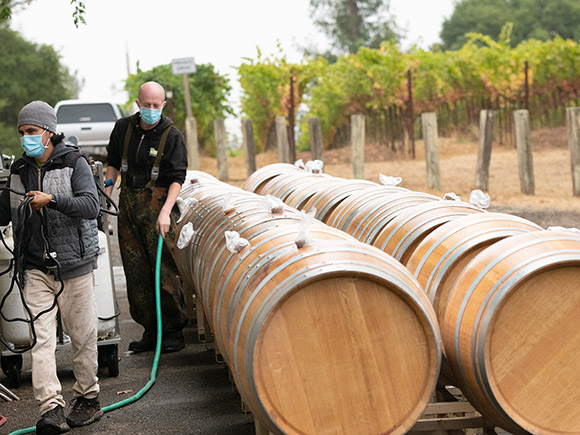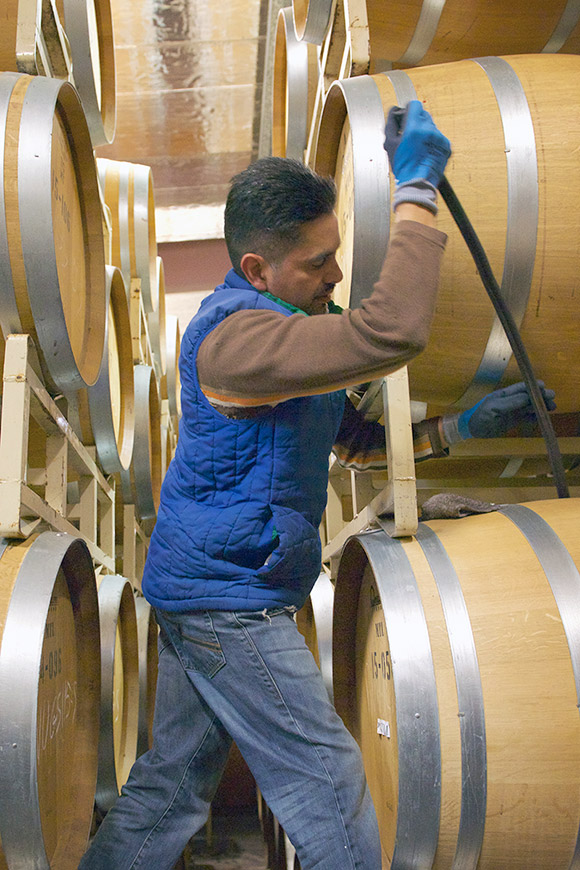We've produced sparkling wine blends of Pinot Noir and Chardonnay for several decades and it seemed to us that the Pinot portion contributes the most body and richness to the cuvées. We decided in 2019 to produce a dry white wine from Pinot Noir grapes—whole-berry pressed exactly as we do for sparkling wine. What's different is the ripeness of the fruit. Sparkling wine grapes are harvested at 18° to 20° Brix when the acidity is high; still wine grapes are harvested at 23° to 25° Brix for fuller flavor. To avoid picking up any red skin pigments we harvested the grapes cold and clusters were placed in the presses without destemming. The clusters were pressed slowly over a couple of hours but since our presses are small for whole-cluster pressing, we could only press a couple of tons of fruit per cycle. Each day when we were harvesting fruit for our
Méthode à l'Ancienne Pinot Noir, we would whole-berry press a few bins each morning for this Blanc de Noir. Consequently, this wine is from fruit grown in four Pinot Noir vineyard sites—with four different clones—with 60% harvested from our higher elevation vineyards.

![[above]](/images/buttons/arrow_up.gif) Ulises and Phil rinsing out seasoned French oak barrels prior to filling them with wine or fermenting juice. When the barrels are empty, we fill them with sulfur dioxide gas to prevent any funk from developing; we pressure wash the inside of the barrels with steaming water to remove the sulfur dioxide before we fill the barrel with wine.
Ulises and Phil rinsing out seasoned French oak barrels prior to filling them with wine or fermenting juice. When the barrels are empty, we fill them with sulfur dioxide gas to prevent any funk from developing; we pressure wash the inside of the barrels with steaming water to remove the sulfur dioxide before we fill the barrel with wine.
Ulises stirring the lees—dead yeast cells—in a barrel. ![[below]](/images/buttons/arrow_down.gif) When yeast cells die, the cell walls break down and release polysaccharides, amino acids and mannoproteins into the wine, influencing the body, aroma and mouthfeel. This wine was stirred every two weeks for six months to keep the lees in suspension.
When yeast cells die, the cell walls break down and release polysaccharides, amino acids and mannoproteins into the wine, influencing the body, aroma and mouthfeel. This wine was stirred every two weeks for six months to keep the lees in suspension.

The juice began fermentation in stainless steel tanks; 25% was transferred to seasoned French oak barrels at the beginning of fermentation and the remaining 75% was racked to barrels half way through fermentation. The wines completed primary fermentation in the barrels without a malolactic fermentation keeping the acidity bright. Peachy tropical flavors progress to cantaloupe; Pinot Noir roundness with surprisingly bright minerality and an opulent mouthfeel.

